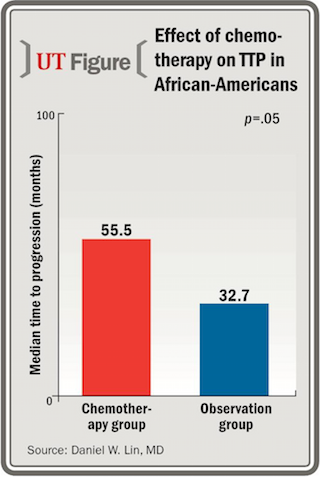Article
Adjuvant chemo well tolerated in high-risk PCa patients
A Veterans Administration Cooperative Study investigating chemotherapy after prostatectomy for high-risk prostate cancer was underpowered to show a statistically significant benefit of early adjuvant chemotherapy versus observation as the standard of care in the primary endpoint analysis of progression-free survival.
San Diego-A Veterans Administration (VA) Cooperative Study investigating chemotherapy after prostatectomy for high-risk prostate cancer (CSP #553) was underpowered to show a statistically significant benefit of early adjuvant chemotherapy versus observation as the standard of care in the primary endpoint analysis of progression-free survival (PFS).
Read: Long-term TRT use reduces risk of CV events, PCa
The data analyses, however, showed a trend favoring treatment with docetaxel (Taxotere) plus prednisone. In addition, early adjuvant chemotherapy was well tolerated, and in pre-specified secondary analyses, it significantly prolonged PFS in men with high-stage (≥pT3b) prostate cancer and in African-Americans.
The findings were reported by Daniel W. Lin, MD, at the AUA annual meeting in San Diego.

Dr. Lin“It is important to note that in the primary endpoint analysis, the magnitude of difference between the two treatment arms in this study is suggestive of significant antitumor activity for docetaxel and similar to that observed in other phase III trials,” said Dr. Lin, who is a study co-chair for CSP #553 and professor and chief of urologic oncology, University of Washington, Seattle. “In addition, the reason why the study was underpowered is that patient accrual was stopped before reaching the planned sample size due to resource limitations within the VA and not because of safety concerns.
“There are challenges for the treatment of high-risk prostate cancer because curative treatments, regardless of modality, are associated with a high recurrence rate. The data from CSP #553 clearly support ongoing and planned trials of systemic chemotherapy for hormone-sensitive prostate cancer.”
CSP #553 had a planned enrollment of 480 patients, but accrual was stopped after about 64 months when 297 patients had been randomized between observation (n=157) and chemotherapy with intravenous docetaxel, 75 mg once every 21 days for six cycles (n=140).
Men were eligible for enrollment if they had a histologic diagnosis of cT1-T2 prostate cancer prior to prostatectomy, an undetectable post-prostatectomy PSA, and any of the following high-risk findings: preoperative PSA >20.0 ng/mL, stage ≥pT3b, stage pT3a with Gleason grade 7-10, or stage pT2R1 with Gleason score 8-10. Node dissection at prostatectomy was mandated, and eligible men had to be node negative.
Also see - Prostate Ca at AUA 2016: PSA drop, active surveillance are key themes
Patients were stratified prior to randomization based on PSA (>20.0 ng/mL vs. ≤20.0 ng/mL), Gleason score (8-10 vs. ≤7), tumor stage (≥pT3b vs. ≤pT3a), and surgical margin status (R1 vs. R0), and the two treatment arms were well matched for these clinical characteristics and in their demographics.
Next - Dr. Lin: Cohort represented very high-risk group

Dr. Lin pointed out that the cohort represented a very high-risk group, as more than one-third of men had a Gleason score of 8-10 and more than one-third had stage ≥pT3b disease.
Read: Prostate HIFU lands in the U.S. Now what?
“The proportion of men with high-grade and high-stage disease is almost double that enrolled in several other adjuvant trials that are in the literature,” he said. “In addition, 25% of men enrolled in CSP #553 were African-American, and so it has by far the highest minority representation among phase III prostate cancer trials.”
How patients fared
After a median follow-up of 62.4 months, median time to progression was 55.5 months in the chemotherapy group and 45.6 months for the observation group (p=.24; hazard ratio [HR]: 0.82; 95% confidence interval (CI): 0.59-1.14). In the pre-specified analysis of patients with tumor stage ≥pT3b, chemotherapy delayed median time to progression by 18 months compared with observation (47.2 vs. 29.2 months, p=.03; HR: 0.57; 95% CI: 0.34-0.96).
“These men with a high-stage tumor might be the patients who really need adjuvant chemotherapy,” Dr. Lin said.
He described the benefit of chemotherapy among African-American men as “even more striking.” In that racial subgroup, chemotherapy delayed the median time to progression by almost 2 years compared with observation (55.5 vs. 32.7 months, p=.05; HR: 0.54; 95% CI: 0.29-1.01).
Adverse events reported in the chemotherapy arm were as expected. The incidence of grade 3-4 hematologic disorders was 46%. Dr. Lin drew attention to a low incidence (2%) of grade 3-4 neutropenia and a single case of a grade 5 treatment-related pneumonia. Other grade 3-4 adverse events occurring at a rate ≥5% included hyperglycemia (20%), infection (11%), and fatigue (5%).
More on Prostate Cancer:
Greater long-term side effect risk with intermittent ADT
No link between PDE-5 use, prostate Ca recurrence
Salvage HIFU shows promise in post-RT PCa patients
Subscribe to Urology Times to get monthly news from the leading news source for urologists.
Newsletter
Stay current with the latest urology news and practice-changing insights — sign up now for the essential updates every urologist needs.












